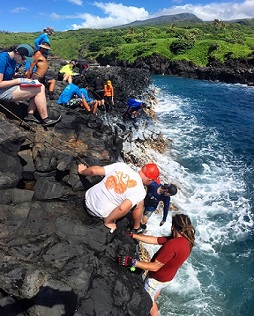- ABOUT US
- PROGRAM AREAS
- CONSERVATION APPROACH
- EDUCATION
- MULTIMEDIA
Community-Driven 'Opihi Restoration Proves Successful

Found only in Hawai'i, 'opihi is a marine limpet that lives suctioned onto rocks where the ocean meets the shoreline. It is a coveted local delicacy and staple of the native Hawai'ian diet. So when communities in East Maui started documenting declines in 'opihi populations, they took action.
With support from NOAA, The Nature Conservancy, and Texas A&M University – Corpus Christi, community members surveyed and measured 'opihi along their shores from 2010 to 2013. After confirming the declines, they considered potential interventions for restoring the population. Knowing 'opihi reproduce every six months and are fast growing, the communities were confident that if the populations were protected, they could grow and replenish successfully.

In 2014, the community groups Kīpahulu 'Ohana and Nā Mamo O Mū'olea decided to revive the traditional practice of resting an area from 'opihi harvest so that it will become abundant again. The concept is simple—allowing one area to rest from harvest means those 'opihi have the chance to grow larger, grow more closely together, and produce more larvae that can be carried by currents to neighboring areas, providing more 'opihi for all. And their efforts paid off—after only three years of implementing rest areas, community members are seeing more 'opihi!
Since 2014, trained surveyors have conducted rapid surveys of 'opihi about three times a year, within rest areas and roughly 100 and 1000 meters from their boundaries. Using rulers and clickers to record the number and size class of 'opihi, volunteers survey sites divided into approximately two meter transects to collect data that is vital to detecting changes in populations and ensuring that the rest areas are having the desired effect. Over the three-year study, more than 200 volunteers have counted and sized 'opihi and collected data from 7,213 transects on two kilometers of coastline.
The surveys revealed up to a tenfold increase in the 100- and 1000-meter comparison areas down current from the rest areas, indicating a spillover effect. The net population growth rate in the rest areas (number of 'opihi per meter per year) increased from two to six times. Overall, larger 'opihi were surveyed in rest areas and more new recruits were observed down current.
The data are providing valuable information on 'opihi population health and spawning patterns, which can help ensure effective long-term management and sustainable harvest.
The community groups continue to monitor the rest areas and encourage voluntary compliance through outreach and education, and their results have inspired neighboring communities to join the effort.
For more information on financial assistance from the Coral Reef Conservation Program, visit: https://coralreef.noaa.gov/conservation/funding_welcome.html.
About Us

The NOAA Coral Reef Conservation Program was established in 2000 by the Coral Reef Conservation Act. Headquartered in Silver Spring, Maryland, the program is part of NOAA's Office for Coastal Management.

The Coral Reef Information System (CoRIS) is the program's information portal that provides access to NOAA coral reef data and products.
Work With US
U.S. Coral Reef Task Force
Funding Opportunities
Employment
Fellowship Program
Contracting Assistance
Graphic Identifier
Featured Stories Archive

Access the archive of featured stories here...
Feedback
Thank you for visiting NOAA’s Coral Reef Conservation Program online. Please take our website satisfaction survey. We welcome your ideas, comments, and feedback. Questions? Email coralreef@noaa.gov.
Stay Connected
Contact Us
NOAA’s Coral Reef Conservation Program
SSMC4, 10th Floor
1305 East West Highway
Silver Spring, MD 20910
coralreef@noaa.gov
